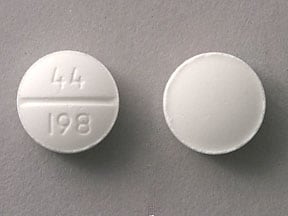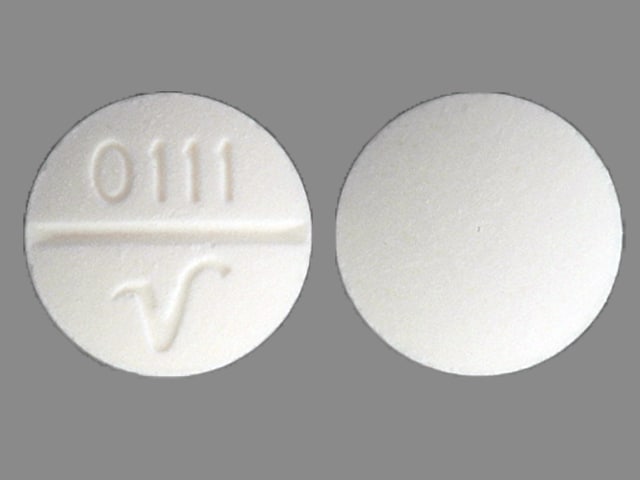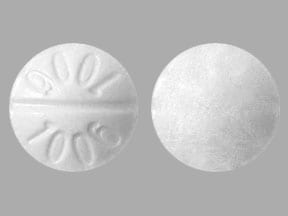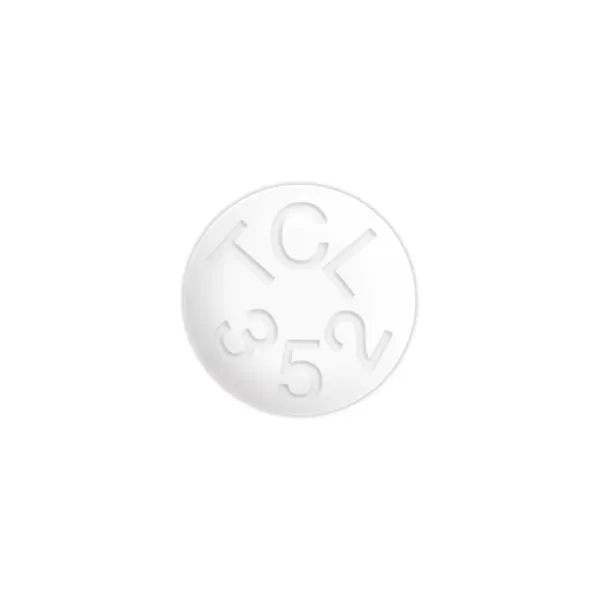Dosage Forms
Excipient information presented when available (limited, particularly for generics); consult specific product labeling. [DSC] = Discontinued product
Solution, Injection:
Generic: 50 mg/mL (1 mL)
Tablet, Oral:
Dramamine: 50 mg
Driminate: 50 mg
Driminate: 50 mg [scored]
GoodSense Motion Sickness: 50 mg [scored]
Motion Sickness: 50 mg [DSC]
Generic: 50 mg [DSC]
Tablet Chewable, Oral:
Dramamine: 50 mg [contains aspartame, fd&c yellow #6 aluminum lake]
Pharmacology
Mechanism of Action
Competes with histamine for H1-receptor sites on effector cells in the gastrointestinal tract, blood vessels, and respiratory tract; blocks chemoreceptor trigger zone, diminishes vestibular stimulation, and depresses labyrinthine function through its central anticholinergic activity
Pharmacokinetics/Pharmacodynamics
Absorption
Well absorbed
Distribution
3 to 4 L/kg (Gravol Canadian labeling 2016)
Metabolism
Extensive in the liver to metabolites (diphenyl-methoxy-ethylamine, diphenyl-methoxy-acetic, diphenyl-methoxy-N-methylamine) (Gravol Canadian labeling 2016)
Excretion
Renal (Gravol Canadian labeling 2016)
Onset of Action
Antiemetic: IV: immediate; IM: 20 to 30 minutes; Oral: 15 to 30 minutes (Gravol Canadian labeling 2016)
Duration of Action
4 to 6 hours (Gravol Canadian labeling 2016)
Half-Life Elimination
5 to 8 hours (Gravol Canadian labeling 2016)
Protein Binding
70% to 85% (Gravol Canadian labeling 2016)
Use: Labeled Indications
US labeling: Motion sickness: Treatment and prevention of nausea, vertigo, and vomiting associated with motion sickness.
Canadian labeling: Nausea, vomiting and/or vertigo: Treatment and prevention of nausea, vomiting and/or vertigo associated with motion sickness, radiation sickness, postoperative recovery, use of other drugs, Mènière disease and other labyrinthine disturbances.
Use: Off Label
Nausea and vomiting of pregnancybyes
Data from a limited number of clinical trials suggest that dimenhydrinate may be beneficial for the treatment of nausea and vomiting of pregnancy (NVP) Babaei 2014, Carliner 1949, Cartwright 1950.
Based on the American College of Obstetricians and Gynecologists (ACOG) and the Society of Obstetricians and Gynaecologists of Canada practice guidelines, dimenhydrinate given for the treatment of NVP is an effective adjunct to doxylamine/pyridoxine in the management of this condition when doxylamine/pyridoxine alone does not provide symptom improvement ACOG 189 2018, Campbell [SOGC] 2016. The Royal College of Obstetricians & Gynaecologists in the UK recommends antihistamines (including dimenhydrinate) and phenothiazines as first-line therapy RCOG 2016.
Contraindications
Hypersensitivity to dimenhydrinate or any component of the formulation; neonates (injection contains benzyl alcohol)
Canadian labeling: Hypersensitivity to dimenhydrinate, its components (diphenhydramine or 8-chlorotheophylline) or any component of the formulation; concurrent use of or use within 14 days following therapy with a monoamine oxidase inhibitor; narrow angle glaucoma; chronic pulmonary disease; prostatic hypertrophy; patients <2 years of age
Dosage and Administration
Dosing: Adult
US labeling: Motion sickness, nausea/vomiting, or vertigo:
Oral: 50 to 100 mg every 4 to 6 hours (maximum: 400 mg/day)
IM, IV: 50 mg every 4 hours; maximum: 100 mg every 4 hours
Canadian labeling: Nausea/vomiting or vertigo:
Motion sickness:
Oral: 50 to 100 mg every 4 hours as necessary (maximum: 400 mg/day); Long acting formulation: 100 mg every 8 to 12 hours (maximum: 300 mg/day)
Rectal: 50 to 100 mg every 6 to 8 hours as necessary
Postoperative nausea/vomiting:
Oral: 50 to 100 mg prior to procedure then 50 to 100 mg post-procedure; repeat as necessary (maximum: 400 mg/day)
IM, IV: 50 mg prior to treatment then 50 mg post-procedure; repeat as necessary (maximum: 400 mg/day)
Radiation sickness:
IM, IV: 50 to 100 mg 30 to 60 minutes prior to treatment; 50 mg 1.5 and 3 hours after treatment. Repeat dose as necessary (maximum: 400 mg/day)
Rectal: 50 to 100 mg 30 to 60 minutes prior to treatment; repeat as necessary (maximum: 400 mg/day)
Nausea and vomiting of pregnancy (off-label use) (Arsenault 2002):
Oral, rectal: 50 to 100 mg every 4 to 6 hours; maximum dose: 200 mg/day (when taking four doxylamine/pyridoxine tablets per day) or 400 mg/day
IV: 50 mg every 4 to 6 hours
Dosing: Geriatric
Avoid use (Beers Criteria [AGS 2019]).
Dosing: Pediatric
Motion sickness, nausea/vomiting, or vertigo, prophylaxis:
Oral products:
Fixed dose: Administer initial dose 30 to 60 minutes before travel/activity
Children ≥2 to <6 years: Oral: 12.5 to 25 mg every 6 to 8 hours; maximum daily dose: 75 mg/24 hours
Children ≥6 years to <12 years: Oral: 25 to 50 mg every 6 to 8 hours; maximum daily dose: 150 mg/24 hours
Children ≥12 years and Adolescents: Oral: 50 to 100 mg every 4 to 6 hours; maximum daily dose: 400 mg/24 hours
Weight-based dosing: Children 2 to 12 years: Oral: Limited data available: 1 to 1.5 mg/kg/dose every 6 hours; maximum dose: 25 mg/dose. First dose should be administered 60 minutes prior to travel (CDC 2017).
Parenteral products: IM:
Weight-based dosing: Infants, Children, and Adolescents: IM: 1.25 mg/kg/dose 4 times daily; maximum daily dose: 300 mg/day
BSA-based dosing: Infants, Children, and Adolescents: IM: 37.5 mg/m2/dose 4 times daily; maximum daily dose: 300 mg/day
Canadian labeling: Rectal suppository [Canadian product]:
Children 2 to ≤5 years: Rectal: 12.5 mg to 25 mg once; if more doses needed, contact health care provider
Children 6 to 7 years: Rectal: 12.5 to 25 mg every 8 to 12 hours as needed
Children 8 to 11 years: Rectal: 25 to 50 mg every 8 to 12 hours as needed
Children ≥12 years and Adolescents: Rectal: 50 mg every 8 to 12 hours as needed
Postoperative nausea and vomiting (PONV): Limited data available:
Prevention: Infants, Children, and Adolescents: IV: 0.5 mg/kg/dose; maximum dose: 25 mg/dose (Gan 2014)
Treatment:
Weight-directed: Infants, Children, and Adolescents: IV: 0.5 mg/kg/dose; maximum dose: 25 mg/dose; for treatment of PONV, use only if prophylaxis fails and dimenhydrinate is from a different pharmacologic class than prophylactic drug (Gan 2014)
Fixed dose (Gravol prescribing information [Canada] 2016):
Children 6 to 7 years: IM, IV: 15 to 25 mg two or three times daily
Children 8 to 12 years: IM, IV: 25 to 50 mg two or three times daily
Children ≥12 years and Adolescents: IM, IV: 50 mg two or three times daily
Reconstitution
Solution for injection:
IM: No dilution required.
IV: Must dilute each 50 mg in 10 mL NS or D5W (Gravol Canadian labeling 2016).
Administration
Oral: To prevent motion sickness, administer 30 to 60 minutes prior to exposure.
Solution for injection:
IM: Administer undiluted
IV: Dilute and inject over 2 minutes. When using for nausea and vomiting of pregnancy, administer dose (diluted in 50 mL of normal saline) over 20 minutes (Arsenault 2002).
Rectal suppository [Canadian product]: To prevent motion sickness, nausea/vomiting, or vertigo, administer 30 minutes prior to event.
Dietary Considerations
Tablets may be taken with food or water. Some products may contain phenylalanine.
Storage
Solution for injection: Store at 20°C to 25°C (68°F to 77°F). Protect from light.
Suppository [Canadian product]: Store at ≤27°C (≤80°F).
DimenhyDRINATE Images
Drug Interactions
Acetylcholinesterase Inhibitors: May diminish the therapeutic effect of Anticholinergic Agents. Anticholinergic Agents may diminish the therapeutic effect of Acetylcholinesterase Inhibitors. Monitor therapy
Aclidinium: May enhance the anticholinergic effect of Anticholinergic Agents. Avoid combination
Alcohol (Ethyl): CNS Depressants may enhance the CNS depressant effect of Alcohol (Ethyl). Monitor therapy
Alizapride: May enhance the CNS depressant effect of CNS Depressants. Monitor therapy
Amantadine: May enhance the anticholinergic effect of Anticholinergic Agents. Monitor therapy
Amezinium: Antihistamines may enhance the stimulatory effect of Amezinium. Monitor therapy
Amphetamines: May diminish the sedative effect of Antihistamines. Monitor therapy
Anticholinergic Agents: May enhance the adverse/toxic effect of other Anticholinergic Agents. Monitor therapy
Azelastine (Nasal): CNS Depressants may enhance the CNS depressant effect of Azelastine (Nasal). Avoid combination
Benzylpenicilloyl Polylysine: Antihistamines may diminish the diagnostic effect of Benzylpenicilloyl Polylysine. Management: Suspend systemic H1 antagonists for benzylpenicilloyl-polylysine skin testing and delay testing until systemic antihistaminic effects have dissipated. A histamine skin test may be used to assess persistent antihistaminic effects. Consider therapy modification
Betahistine: Antihistamines may diminish the therapeutic effect of Betahistine. Monitor therapy
Blonanserin: CNS Depressants may enhance the CNS depressant effect of Blonanserin. Consider therapy modification
Botulinum Toxin-Containing Products: May enhance the anticholinergic effect of Anticholinergic Agents. Monitor therapy
Brexanolone: CNS Depressants may enhance the CNS depressant effect of Brexanolone. Monitor therapy
Brimonidine (Topical): May enhance the CNS depressant effect of CNS Depressants. Monitor therapy
Bromopride: May enhance the CNS depressant effect of CNS Depressants. Monitor therapy
Bromperidol: May enhance the CNS depressant effect of CNS Depressants. Avoid combination
Buprenorphine: CNS Depressants may enhance the CNS depressant effect of Buprenorphine. Management: Consider reduced doses of other CNS depressants, and avoiding such drugs in patients at high risk of buprenorphine overuse/self-injection. Initiate buprenorphine at lower doses in patients already receiving CNS depressants. Consider therapy modification
Cannabidiol: May enhance the CNS depressant effect of CNS Depressants. Monitor therapy
Cannabis: May enhance the CNS depressant effect of CNS Depressants. Monitor therapy
Chloral Betaine: May enhance the adverse/toxic effect of Anticholinergic Agents. Monitor therapy
Chlormethiazole: May enhance the CNS depressant effect of CNS Depressants. Management: Monitor closely for evidence of excessive CNS depression. The chlormethiazole labeling states that an appropriately reduced dose should be used if such a combination must be used. Consider therapy modification
Chlorphenesin Carbamate: May enhance the adverse/toxic effect of CNS Depressants. Monitor therapy
Cimetropium: Anticholinergic Agents may enhance the anticholinergic effect of Cimetropium. Avoid combination
CNS Depressants: May enhance the adverse/toxic effect of other CNS Depressants. Monitor therapy
Dimethindene (Topical): May enhance the CNS depressant effect of CNS Depressants. Monitor therapy
Doxylamine: May enhance the CNS depressant effect of CNS Depressants. Management: The manufacturer of Diclegis (doxylamine/pyridoxine), intended for use in pregnancy, specifically states that use with other CNS depressants is not recommended. Monitor therapy
Dronabinol: May enhance the CNS depressant effect of CNS Depressants. Monitor therapy
Droperidol: May enhance the CNS depressant effect of CNS Depressants. Management: Consider dose reductions of droperidol or of other CNS agents (eg, opioids, barbiturates) with concomitant use. Exceptions to this monograph are discussed in further detail in separate drug interaction monographs. Consider therapy modification
Eluxadoline: Anticholinergic Agents may enhance the constipating effect of Eluxadoline. Avoid combination
Esketamine: May enhance the CNS depressant effect of CNS Depressants. Monitor therapy
Flunitrazepam: CNS Depressants may enhance the CNS depressant effect of Flunitrazepam. Consider therapy modification
Gastrointestinal Agents (Prokinetic): Anticholinergic Agents may diminish the therapeutic effect of Gastrointestinal Agents (Prokinetic). Monitor therapy
Glucagon: Anticholinergic Agents may enhance the adverse/toxic effect of Glucagon. Specifically, the risk of gastrointestinal adverse effects may be increased. Monitor therapy
Glycopyrrolate (Oral Inhalation): Anticholinergic Agents may enhance the anticholinergic effect of Glycopyrrolate (Oral Inhalation). Avoid combination
Glycopyrronium (Topical): May enhance the anticholinergic effect of Anticholinergic Agents. Avoid combination
Hyaluronidase: Antihistamines may diminish the therapeutic effect of Hyaluronidase. Management: Patients receiving antihistamines (particularly at larger doses) may not experience the desired clinical response to standard doses of hyaluronidase. Larger doses of hyaluronidase may be required. Consider therapy modification
HYDROcodone: CNS Depressants may enhance the CNS depressant effect of HYDROcodone. Management: Avoid concomitant use of hydrocodone and benzodiazepines or other CNS depressants when possible. These agents should only be combined if alternative treatment options are inadequate. If combined, limit the dosages and duration of each drug. Consider therapy modification
HydrOXYzine: May enhance the CNS depressant effect of CNS Depressants. Monitor therapy
Ipratropium (Oral Inhalation): May enhance the anticholinergic effect of Anticholinergic Agents. Avoid combination
Itopride: Anticholinergic Agents may diminish the therapeutic effect of Itopride. Monitor therapy
Kava Kava: May enhance the adverse/toxic effect of CNS Depressants. Monitor therapy
Lemborexant: May enhance the CNS depressant effect of CNS Depressants. Management: Dosage adjustments of lemborexant and of concomitant CNS depressants may be necessary when administered together because of potentially additive CNS depressant effects. Close monitoring for CNS depressant effects is necessary. Consider therapy modification
Levosulpiride: Anticholinergic Agents may diminish the therapeutic effect of Levosulpiride. Avoid combination
Lofexidine: May enhance the CNS depressant effect of CNS Depressants. Management: Drugs listed as exceptions to this monograph are discussed in further detail in separate drug interaction monographs. Monitor therapy
Magnesium Sulfate: May enhance the CNS depressant effect of CNS Depressants. Monitor therapy
Methotrimeprazine: CNS Depressants may enhance the CNS depressant effect of Methotrimeprazine. Methotrimeprazine may enhance the CNS depressant effect of CNS Depressants. Management: Reduce adult dose of CNS depressant agents by 50% with initiation of concomitant methotrimeprazine therapy. Further CNS depressant dosage adjustments should be initiated only after clinically effective methotrimeprazine dose is established. Consider therapy modification
MetyroSINE: CNS Depressants may enhance the sedative effect of MetyroSINE. Monitor therapy
Mianserin: May enhance the anticholinergic effect of Anticholinergic Agents. Monitor therapy
Minocycline (Systemic): May enhance the CNS depressant effect of CNS Depressants. Monitor therapy
Mirabegron: Anticholinergic Agents may enhance the adverse/toxic effect of Mirabegron. Monitor therapy
Nabilone: May enhance the CNS depressant effect of CNS Depressants. Monitor therapy
Nitroglycerin: Anticholinergic Agents may decrease the absorption of Nitroglycerin. Specifically, anticholinergic agents may decrease the dissolution of sublingual nitroglycerin tablets, possibly impairing or slowing nitroglycerin absorption. Monitor therapy
Opioid Agonists: CNS Depressants may enhance the CNS depressant effect of Opioid Agonists. Management: Avoid concomitant use of opioid agonists and benzodiazepines or other CNS depressants when possible. These agents should only be combined if alternative treatment options are inadequate. If combined, limit the dosages and duration of each drug. Consider therapy modification
Orphenadrine: CNS Depressants may enhance the CNS depressant effect of Orphenadrine. Avoid combination
Oxatomide: May enhance the anticholinergic effect of Anticholinergic Agents. Avoid combination
Oxomemazine: May enhance the CNS depressant effect of CNS Depressants. Avoid combination
OxyCODONE: CNS Depressants may enhance the CNS depressant effect of OxyCODONE. Management: Avoid concomitant use of oxycodone and benzodiazepines or other CNS depressants when possible. These agents should only be combined if alternative treatment options are inadequate. If combined, limit the dosages and duration of each drug. Consider therapy modification
Paraldehyde: CNS Depressants may enhance the CNS depressant effect of Paraldehyde. Avoid combination
Perampanel: May enhance the CNS depressant effect of CNS Depressants. Management: Patients taking perampanel with any other drug that has CNS depressant activities should avoid complex and high-risk activities, particularly those such as driving that require alertness and coordination, until they have experience using the combination. Consider therapy modification
Piribedil: CNS Depressants may enhance the CNS depressant effect of Piribedil. Monitor therapy
Pitolisant: Antihistamines may diminish the therapeutic effect of Pitolisant. Avoid combination
Potassium Chloride: Anticholinergic Agents may enhance the ulcerogenic effect of Potassium Chloride. Management: Patients on drugs with substantial anticholinergic effects should avoid using any solid oral dosage form of potassium chloride. Avoid combination
Potassium Citrate: Anticholinergic Agents may enhance the ulcerogenic effect of Potassium Citrate. Avoid combination
Pramipexole: CNS Depressants may enhance the sedative effect of Pramipexole. Monitor therapy
Pramlintide: May enhance the anticholinergic effect of Anticholinergic Agents. These effects are specific to the GI tract. Consider therapy modification
Ramosetron: Anticholinergic Agents may enhance the constipating effect of Ramosetron. Monitor therapy
Revefenacin: Anticholinergic Agents may enhance the anticholinergic effect of Revefenacin. Avoid combination
ROPINIRole: CNS Depressants may enhance the sedative effect of ROPINIRole. Monitor therapy
Rotigotine: CNS Depressants may enhance the sedative effect of Rotigotine. Monitor therapy
Rufinamide: May enhance the adverse/toxic effect of CNS Depressants. Specifically, sleepiness and dizziness may be enhanced. Monitor therapy
Secretin: Anticholinergic Agents may diminish the therapeutic effect of Secretin. Management: Avoid concomitant use of anticholinergic agents and secretin. Discontinue anticholinergic agents at least 5 half-lives prior to administration of secretin. Consider therapy modification
Selective Serotonin Reuptake Inhibitors: CNS Depressants may enhance the adverse/toxic effect of Selective Serotonin Reuptake Inhibitors. Specifically, the risk of psychomotor impairment may be enhanced. Monitor therapy
Sodium Oxybate: May enhance the CNS depressant effect of CNS Depressants. Management: Consider alternatives to combined use. When combined use is needed, consider minimizing doses of one or more drugs. Use of sodium oxybate with alcohol or sedative hypnotics is contraindicated. Consider therapy modification
Suvorexant: CNS Depressants may enhance the CNS depressant effect of Suvorexant. Management: Dose reduction of suvorexant and/or any other CNS depressant may be necessary. Use of suvorexant with alcohol is not recommended, and the use of suvorexant with any other drug to treat insomnia is not recommended. Consider therapy modification
Tapentadol: May enhance the CNS depressant effect of CNS Depressants. Management: Avoid concomitant use of tapentadol and benzodiazepines or other CNS depressants when possible. These agents should only be combined if alternative treatment options are inadequate. If combined, limit the dosages and duration of each drug. Consider therapy modification
Tetrahydrocannabinol: May enhance the CNS depressant effect of CNS Depressants. Monitor therapy
Tetrahydrocannabinol and Cannabidiol: May enhance the CNS depressant effect of CNS Depressants. Monitor therapy
Thalidomide: CNS Depressants may enhance the CNS depressant effect of Thalidomide. Avoid combination
Thiazide and Thiazide-Like Diuretics: Anticholinergic Agents may increase the serum concentration of Thiazide and Thiazide-Like Diuretics. Monitor therapy
Tiotropium: Anticholinergic Agents may enhance the anticholinergic effect of Tiotropium. Avoid combination
Topiramate: Anticholinergic Agents may enhance the adverse/toxic effect of Topiramate. Monitor therapy
Trimeprazine: May enhance the CNS depressant effect of CNS Depressants. Monitor therapy
Umeclidinium: May enhance the anticholinergic effect of Anticholinergic Agents. Avoid combination
Zolpidem: CNS Depressants may enhance the CNS depressant effect of Zolpidem. Management: Reduce the Intermezzo brand sublingual zolpidem adult dose to 1.75 mg for men who are also receiving other CNS depressants. No such dose change is recommended for women. Avoid use with other CNS depressants at bedtime; avoid use with alcohol. Consider therapy modification
Adverse Reactions
Frequency not defined.
Cardiovascular: Tachycardia
Central nervous system: Dizziness, drowsiness, excitement, headache, insomnia, lassitude, nervousness, restlessness
Dermatologic: Skin rash
Gastrointestinal: Anorexia, epigastric distress, nausea, xerostomia
Genitourinary: Dysuria
Ophthalmic: Blurred vision
Respiratory: Thickening of bronchial secretions
Warnings/Precautions
Concerns related to adverse effects:
- CNS depression: May cause CNS depression, which may impair physical or mental abilities; patients must be cautioned about performing tasks which require mental alertness (eg, operating machinery or driving). Other CNS effects which may be observed, particularly at higher dosages include euphoria, hallucinations, confusion, temporary amnesia and paranoia.
- Dermatologic reactions: Rare cases of serious skin reactions (eg, Stevens-Johnson syndrome, toxic epidermal necrolysis, erythema multiforme) have been reported; discontinue use if skin rash develops and consult health care provider.
Disease-related concerns:
- Cardiovascular disease: Use with caution in patients with cardiovascular disease (including arrhythmias, hypertension and ischemic heart disease).
- Hepatic impairment: Use with caution in patients with hepatic impairment.
- Increased intraocular pressure/glaucoma: Use with caution in patients with increased intraocular pressure or angle-closure glaucoma.
- Prostatic hyperplasia/urinary obstruction: Use with caution in patients with prostatic hyperplasia and/or GU obstruction.
- Pyloroduodenal obstruction: Use with caution in patients with pyloroduodenal obstruction (including stenotic peptic ulcer).
- Respiratory disease: Use with caution in patients with a history of asthma or lower respiratory tract symptoms.
- Seizures: Use with caution in patients with seizure disorders.
- Thyroid dysfunction: Use with caution in patients with thyroid dysfunction.
Concurrent drug therapy issues:
- Antibiotics: Use caution if used in conjunction with antibiotics that have the potential to cause ototoxicity. Dimenhydrinate may mask symptoms of ototoxicity.
- Drug-drug interactions: Potentially significant interactions may exist, requiring dose or frequency adjustment, additional monitoring, and/or selection of alternative therapy. Consult drug interactions database for more detailed information.
Special populations:
- Elderly: Use with caution in the elderly; may be more sensitive to adverse effects.
- Pediatric: Antihistamines may cause excitation in young children. Not for OTC use in children <2 years of age.
Dosage form specific issues:
- Benzyl alcohol and derivatives: Some dosage forms may contain sodium benzoate/benzoic acid; benzoic acid (benzoate) is a metabolite of benzyl alcohol; large amounts of benzyl alcohol (≥99 mg/kg/day) have been associated with a potentially fatal toxicity ("gasping syndrome") in neonates; the "gasping syndrome" consists of metabolic acidosis, respiratory distress, gasping respirations, CNS dysfunction (including convulsions, intracranial hemorrhage), hypotension and cardiovascular collapse (AAP 1997; CDC 1982); some data suggests that benzoate displaces bilirubin from protein binding sites (Ahlfors 2001); avoid or use dosage forms containing benzyl alcohol derivative with caution in neonates. See manufacturer's labeling.
- Parenteral formulations: Do not inject intra-arterially.
- Phenylalanine: Some products may contain phenylalanine.
- Polysorbate 80: Some dosage forms may contain polysorbate 80 (also known as Tweens). Hypersensitivity reactions, usually a delayed reaction, have been reported following exposure to pharmaceutical products containing polysorbate 80 in certain individuals (Isaksson 2002; Lucente 2000; Shelley 1995). Thrombocytopenia, ascites, pulmonary deterioration, and renal and hepatic failure have been reported in premature neonates after receiving parenteral products containing polysorbate 80 (Alade 1986; CDC 1984). See manufacturer's labeling.
- Propylene glycol: Some dosage forms may contain propylene glycol; large amounts are potentially toxic and have been associated with hyperosmolality, lactic acidosis, seizures and respiratory depression; use caution (AAP 1997; Zar 2007). See manufacturer's labeling.
Other warnings/precautions:
- Abuse/withdrawal: Has abuse potential due to its hallucinogenic and euphoric effects; discontinuation after chronic abuse may lead to withdrawal symptoms (eg, lethargy, agitation, hostility, hallucinations, confusion, aggression, nausea/vomiting).
Pregnancy
Pregnancy Risk Factor
B
Pregnancy Considerations
Dimenhydrinate crosses the placenta. The risk of fetal abnormalities was not increased following maternal use of dimenhydrinate during any trimester of pregnancy.
Dimenhydrinate may be used for the adjunctive treatment of nausea and vomiting of pregnancy (ACOG 189 2018; Campbell 2016). Dimenhydrinate may have an oxytocic effect if used during labor.
Patient Education
What is this drug used for?
- It is used to help motion sickness.
- It is used to treat or prevent upset stomach and throwing up.
Frequently reported side effects of this drug
- Dizziness
- Fatigue
- Dry mouth
- Dry throat
- Anxiety
- Headache
- Lack of appetite
- Trouble sleeping
- Loss of strength and energy
- Nasal dryness
Other side effects of this drug: Talk with your doctor right away if you have any of these signs of:
- Difficult urination
- Painful urination
- Fast heartbeat
- Blurred vision
- Agitation
- Signs of a significant reaction like wheezing; chest tightness; fever; itching; bad cough; blue skin color; seizures; or swelling of face, lips, tongue, or throat.
Note: This is not a comprehensive list of all side effects. Talk to your doctor if you have questions.
Consumer Information Use and Disclaimer: This information should not be used to decide whether or not to take this medicine or any other medicine. Only the healthcare provider has the knowledge and training to decide which medicines are right for a specific patient. This information does not endorse any medicine as safe, effective, or approved for treating any patient or health condition. This is only a brief summary of general information about this medicine. It does NOT include all information about the possible uses, directions, warnings, precautions, interactions, adverse effects, or risks that may apply to this medicine. This information is not specific medical advice and does not replace information you receive from the healthcare provider. You must talk with the healthcare provider for complete information about the risks and benefits of using this medicine.








